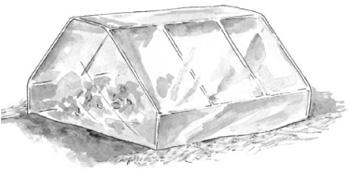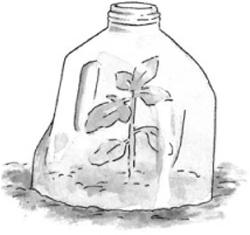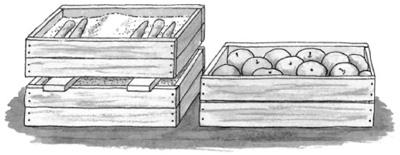Just in Case (47 page)

Plants don’t have to be grown in traditional clay pots. I grew a wonderful crop of cucumbers in an old metal washtub. A plastic storage bin is large enough to support a squash plant that will keep you supplied all summer, and a reclaimed wading pool is just the place for some mixed greens.
GETTING STARTED
If you are a novice gardener, the first thing you should acquire, well before you put a single seed in the ground, would be a few good gardening books. Although you may peruse some selections at your local library, gardening books are something you want to have in your preparedness library. Bruce and I have gardened for years, but we still consult our library nearly every day for suggestions on soil requirements, pest problems, and harvesting. We also subscribe to three periodicals that offer excellent articles on new and heirloom plant varieties as well as gardening tips and techniques. Scattered throughout magazines devoted to gardening you will find the phone numbers and order forms for dozens of seed and gardening catalogs; order several of these for inspiration.
The problem with too much inspiration is that you might be inclined to get carried away with your first gardening attempts. You can waste an awful lot of money on unnecessary tools and gadgets, not to mention finding yourself saddled with eighty packets of seeds, a twenty-thousand-dollar garden tractor, and a ten-foot-square garden patch. It is best to start small and hardy. Beans, peas, tomatoes, and leaf lettuce are a good place to begin. You can get them in the ground with little more than a good garden trowel. They are reliable, nearly everyone likes them, and they are easy to preserve if you have an overabundance. (Most people seem to start with zucchini, but I wouldn’t bother. By August, there is so much free zucchini on the roadside that it seems silly to waste precious garden space on it.)
Before you decide what and where to plant, figure out what growing zone you live in. The continent is divided by climate into growing zones 1 through 11, based on average minimum temperatures. This information is available from the USDA Plant Hardiness Zone Map, which you can find online or in most seed catalogs. Bear in mind that just because your town or county is said to be in one zone does not mean that your particular home is not actually one zone different. For example, I live in zone 4, but my proximity to a low-lying river means that my garden is actually in zone 3 and prone to early frost. This information is valuable because seed catalogs often list plants, particularly perennials, as being hardy or able to produce in certain zones.

CDLD FRAME
It is possible to extend your growing season in one of the cooler zones with the help of cold frames and row covers and by starting seeds indoors weeks before they could survive outside. This is one of the many reasons good reference books are invaluable. I have used milk jugs with the bottoms removed and plastic storage tubs as mini greenhouses with great success.
Don’t expect your first crops to look or produce anything like the seed packets claimed

MILK JUG GREENHDUSE
unless you douse your plants with a hefty dose of fertilizer and pesticides — and I don’t recommend you do. For the sake of your own health and that of everyone else in the world, stick with organic methods and expect some losses to bugs, birds, and bunnies. Every year, I plant my beans and watch the rabbits eat off the tops and break my heart. But the tops always grow back, and I seem to end up with more beans than I need. We control Japanese beetles by picking them off each raspberry plant in the early morning and dropping the little devils into a can of water. Cutworms are stymied by a paper collar around the base of each bean plant, and slugs drown in saucers of beer. This is the kind of information you can get from gardening books and magazines and from other local gardeners.
When you need help, contacting your local agricultural extension service is a very good idea. Their gardening advice is free and extremely helpful when you are getting started. An agent may even be able to guide you to some classes and workshops. The other great resource is a good garden center. Don’t bother with one of those places that caters to folks who collect exotic orchids, but find a center that serves the gardener who is planning on his garden to feed his family. The staff there will know what will really grow and what pests you are likely to have to deal with.
OUTSIDE-THE-HOME OPTIONS
If you wish to grow more food than you have space for, look into using a community garden plot or joining a community-supported agriculture (CSA) program. CSAs give people an opportunity to purchase a share in a large garden. Every week during the growing season, the shareowners get a portion of the harvest. Depending on location, the season may run from late April until early November. Some CSAs also offer eggs, honey, and meat for an additional charge. In some cases shareowners are expected to work a few hours a summer on the farm.
A community garden is owned by an entity, often a city or town, that offers the space to citizens for their personal gardening use for a nominal fee. Each person is responsible for his or her own plot, deciding what to plant, how to care for the plot, and when to harvest. A community garden provides freedom of choice, but it is a lot more work than a CSA.
Both options offer the possibility of a community where skills, labor, and tools can be shared. In joining, you will likely also find others willing to preserve their harvest cooperatively.
CDLD STDRAGE
I
N MY DREAM
home, there are two dedicated cold storage rooms. One is dry and just cool, for the storage of squash, sweet potatoes, and pumpkins. The other is moist and cold, for my apples, cabbages, and root crops. For now, I have to make do with what I have, which is a damp, slightly too warm basement with poor airflow, an unheated attic, and an outdoor shed.
In spite of my lack of an actual root cellar, I store as much as possible in its natural state. Cold storage is the least expensive, easiest, and most convenient storage method. It also offers the best opportunity for winter access to produce that is still at its peak in terms of flavor and nutrition. In terms of preparedness, nothing could be better.
When looking into cold storage, start with the basics. Examine your home for the places fruits and vegetables might be kept. The following conditions are desirable:
•
Even temperature.
Cool for some produce, just above freezing for others. Temperature swings are worse than a constant temperature a few degrees above or below what is optimal.
•
Good ventilation.
Good airflow will help control mold and mildew.
•
Protection from pests.
Rodents such as rats, mice, and squirrels can get into the tiniest openings and ruin a basket of apples overnight. They can also chew through wood and plastic.
•
Appropriate humidity.
Some produce needs dry air; some prefers some moisture.
•
Protection from light.
Light, whether sunlight or artificial, is the enemy of all stored foods.
An unheated garage, a well-ventilated attic, and a basement all offer possibilities for storage.
You must next determine what foods you are most likely to store and use, and match them to the appropriate space. I know folks who stored a dozen winter squash because they got them for free. The trouble was that squash was not a food they much cared for. They kept the squash in their basement, never giving them another thought until they all rotted, creating a dreadful mess. As with all things you store with the idea of preparedness in mind, use it or lose it. Food is just clutter unless you eat it.
Fruits and vegetable have very particular needs. They like just the right temperature and humidity to store well in peak condition. Even with perfect conditions, no food will last indefinitely. The maximum storage time for individual fruits and vegetables varies from a few weeks for asparagus to five months for winter squash. Those time frames will be greatly affected by only a few degrees above what is optimal. It is best to check your storage food often, removing any food that begins to show signs of spoilage. One rotted apple or potato can ruin an entire bushel, leaving you with a smelly mess.
The easiest foods to store are apples, potatoes, carrots, and winter squash. These are also easy foods to grow and are available for bulk purchase from farmers markets and roadside stands. Once you have some success with these crops, you can move on to others that have similar storage requirements. Try not to get carried away and attempt to do too much in the beginning.
APPLES
Begin by choosing a variety that stores well. McIntosh, Cortland, Red Delicious, and Rome Beauty all store between five and seven months before getting mealy. Apples must be stored away from potatoes and onions. Do not store drops, the apples that have fallen from trees. They will be less expensive but they are bruised and will quickly spoil a whole crate.
Apples do best in temperatures as close to freezing as possible. Don’t try to store apples in one large crate. The weight can spoil the apples on the bottom. I wrap each apple in a sheet of newspaper, then store them in boxes only a few layers deep. If the apples begin to get mealy, convert them to sauce.
POTATOES
Store only mature potatoes. Pick out any that are immature or damaged or show signs of blight. Do not store potatoes near apples.
Spuds like it a bit warmer than apples. Even 50°F is not too warm. Their storage space must be dark. Light will turn potatoes green. The green part tastes awful and is not good to eat, although it can be cut away. I store my potatoes in baskets with an inch or two of clean, dry straw between each layer. I have had late potatoes last six months. The timing is just right: Just about the time they are getting soft and sprouting little eyes, it is time to plant them for a new crop.
CARROTS
Store only perfect carrots. Imperfect specimens can be cut up and canned or frozen. The thicker the carrot, the better, as slender carrots dry out more quickly.
Don’t wash carrots for storage. Just cut off the green tops, brush off as much dirt as you can, and then layer them in sand. You need to have about two inches of sand between each layer. The sand must be kept moist or the carrots will shrivel. I put in one layer of sand, mist with water, then a layer of carrots, then a layer of sand, and mist again. As I use up a layer of carrots, I re-mist the sand if it has dried out. If your carrots do begin to shrivel, you can bring them all out and can them rather than lose them.
Carrots like it on the cold side, and they store well with apples. In areas with less severe winters, carrots can be kept all winter right in the ground. Mulch deeply to keep the ground from freezing too solidly and dig up carrots as you need them. I tried this once but it didn’t work for me; when the temperature is hovering around freezing and there is a foot of snow on the ground, it seems easier to do without carrots than to go outside and dig for them.
Carrots will keep four to five months in very good condition. Beets can be stored in the same way as carrots, but they don’t last as long.
WINTER SQUASH
Hubbard, butternut, and acorn squashes and pumpkins are all good choices for cold storage. Pick mature squash with tough outer skin. You shouldn’t be able to pierce the skin with a fingernail. Squashes like it a bit warmer than freezing and do well stored with potatoes. They need to be stored on a shelf off the ground and not piled up. I used to have a problem with mold on my Hubbard squash after a few months in storage, but I started wiping off the shells with a ten-to-one water/ bleach solution before storing them and that took care of the problem. Squash will keep about six months.
